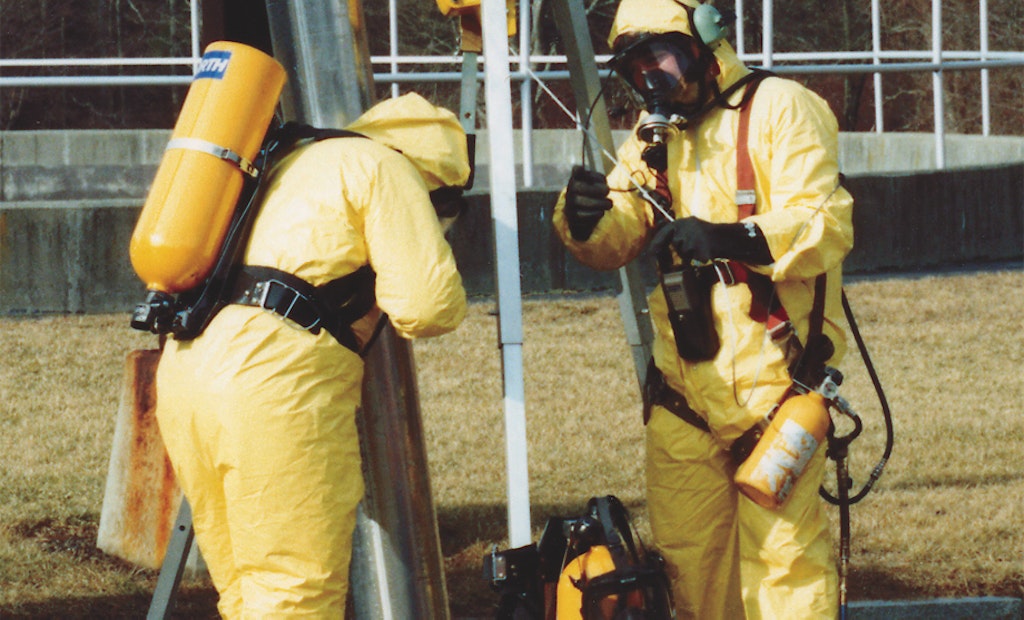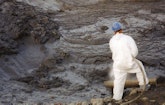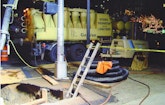
Interested in Safety?
Get Safety articles, news and videos right in your inbox! Sign up now.
Safety + Get AlertsTake a look at the Advanced Pollution Control Corporation article featured 10 years ago in Cleaner magazine. We spotlight the company again in a follow-up story to see how the business has evolved over the last decade: “Cleaner Rewind: Market Shift Creates Realignment for APC.”
For 60 hours over three days, crews from Advanced Pollution Control Corporation (APC) in Bridgewater, Mass., fought a fire in 450 tons of coal in a power plant’s silo.
“The fire may have started during repair to a mechanism that supplies coal to the boilers,” says Michael F. “Mike” Flaherty III, APC owner and president. “Pockets of methane gas may have collected in the coal and ignited somehow. A smoldering silo has to be put out and emptied very carefully. We quenched the fire with water, and when the coal was safe to handle we trucked it out. We removed 68 truckloads of bituminous coal cinders.”
The process was complex. The base of the smoldering silo was on the ninth floor of the power plant. APC had to move the coal using the piping that normally feeds the boiler so that air could flow through the silo to dissipate the methane gas. APC was called because working around methane gas is extremely dangerous, and the firm’s utility clients know of its strict adherence to safety rules and protocols.
“We’ve helped put out enough silo fires that sometimes local fire departments come to us and ask if we’re the ‘silo-put-out-fire’ people,” Mike says. In addition to power plants, the firm works for wastewater treatment plants and municipalities. It spent 14 years on Boston’s 2-mile-long Central Artery/Tunnel Project (“The Big Dig”).
“What is most significant is that Mike’s company faces circumstances like this every day – and over the last five years they have done this safely without a single lost work day accident,” says Charles “Chuck” Porpora, APC’s safety consultant.
Safety philosophy
APC’s corporate safety practices are simple but comprehensive. Each employee carries – to work, all day at work, and home at night – a personal-safety gym bag imprinted with his or her name and employee number, and APC’s name. The bag contains the employee’s personal respirators, safety glasses, goggles, face shields, gloves, and fall-protection gear (full-body harness and lanyard). The safety bags receive spot inspections.
Work-crew members also carry a company-provided Nextel combination two-way radio and cellular phone. Crews arrive early at every job site and bring a fully equipped safety trailer to each job, even when it isn’t required.
“If you arrive fully equipped for all possibilities, you may be asked to perform additional jobs while you’re servicing a client,” says Mike. “Also, we often service clients hundreds of miles from our facility, so there is no going back for a missing tool, or trying to find one locally.”
All foremen use a company checklist to prepare for each day’s job, and when the day’s work is done. APC mechanics use the same list to spot-check all of the firm’s vehicles and equipment.
APC crews are on call around the clock. Mike’s business card bears 24-hour office and home emergency telephone numbers. “Any morning, we can receive an unexpected call from a client at 4:45 a.m. asking us to be on a job site by 6 a.m.,” he says. “We’re our clients’ extra set of hands, with specialty equipment and expertise.”
Athletic background
Mike sees himself as a “safety coach,” bringing to APC the same educational and motivational techniques he used in his years as a teacher and athletic coach. In college, he took part in track and field, caught for the baseball team, and played center in ice hockey. After graduation, he taught high school health and physical education classes for three years and coached baseball, ice hockey, lacrosse and soccer.
“Coaching life safety and motivating people every day is easier in a corporate setting than in athletics because employees are rewarded with pay,” he says.
At each APC job site, every day begins with a tailgate safety talk. The foreman keeps a log to record what was discussed and who was present. Foremen and other employees suggest topics, which may include safety issues and better ways to do the job or a particular part of it. “These discussions help us do a better job,” Mike says.
So does access to safety equipment and supplies. “Our locker room is fitted with countertops and cabinets, similar to those in a household kitchen,” Mike says. “That’s where we store all our respirator parts, including cartridges, and gas monitors to analyze the atmosphere in which we work. Everyone has 100 percent access to these supplies so they can keep their safety bags current and their trucks well supplied.” APC organizes the equipment stored on its trucks in cabinets like those on fire trucks. “We can grab and use any of our equipment quickly just as firemen do,” says Mike.
Safety trailers
Mike put together APC’s first safety trailers in 1980, and the equipment they carry has advanced in quantity and sophistication through the years. “They’re equipped with Level B breathing equipment for working in bad air in confined spaces – SCBA (self-contained breathing apparatus), or cascade breathing systems with four bottles, each with 250 cubic feet of air, good for about eight hours apiece,” says Mike.
“A hose no longer than 300 feet connects the bottles to a worker’s personalized breathing mask. We use a cascade breathing system when we want to avoid having the crew members work with 40-pound bottles on their backs.”
The safety trailers carry rescue and retrieval tripods used in confined spaces. Tripods can be placed over a manhole to raise and lower workers and to retrieve them if something goes wrong. Other fall-protection and safety equipment brought to the job site includes winches and beam trolleys, Tyvek suits (paper coveralls that protect workers’ clothing from contact with waste), encapsulated suits, ventilation fans, rain gear, and extra rubber boots and gloves.
Supporting the safety trailers is a 4,800-square-foot room lined with shelves for storage of specialized equipment APC has designed and built over 25 years. Everyone in the company has access to the room. APC crews also carry to job sites every imaginable safety sign. Mike closely follows all laws, especially those regarding street lane closures.
Classes and communications
All APC employee have an annual medical evaluation that allows them to wear a respirator while working. The tests include pulmonary function, respirator fitness, and blood tests for arsenic, lead, and heavy metals.
Each year, APC holds recertification classes to review the safe use of all of its equipment. “These classes are required by our utility clients,” Mike says. “Everyone takes the classes, including me and our office manager, Carleen Sullivan. Carleen has to understand what her co-workers do because she occasionally visits our job sites. Often she is asked to explain our safety systems to our clients.”
The Nextel radio-telephones communicate with a base station in the APC office. In an emergency, Carleen can contact the entire staff with the push of one button, summoning extra manpower to provide assistance.
For the comfort and safety of its employees, APC installs Air-Ride seats and Air-Ride cabs on its truck. “We don’t beat the heck out of our employees, who often have to drive to job sites a couple hundred miles from Boston,” Mike says.
APC never has hired subcontractors. “We always want to control and own our own equipment,” Mike says. “We like to send out on jobs the most powerful and best-maintained equipment available. Doing this allows us to maintain direct control of productivity and safety on all of our jobs, which usually results in high customer satisfaction and overall lower job cost.”
The one exception to that rule is changing flat tires on an oversized truck. “My mechanics and drivers are trained to change tires mounted on a truck, but our tire providers’ staff are more skilled in the hazards of tire changes on single- and multi-piece truck-tire rims,” says Mike. “They come wherever they are needed to change our tires.”
Hands-on executive
Mike spends considerable time in the field. Before APC sends a crew to a new job site, he visits and takes notes. Later he meets with the foreman to discuss the equipment and safety considerations the job requires. The morning a job is scheduled to begin, he travels to the job site with the foreman to analyze the situation and set up the equipment.
“Mike makes his whole program work for APC,” says Chuck. “If he can’t do something safely, he won’t do it, and APC employees never fear being fired or disciplined if they refuse to do something for safety reasons.
“When employees see a safety problem, Mike always says ‘Let’s sit down and talk about the issue from top to bottom.’ Over the years, he’s had in place more safety systems than most other contractors. When I first went to Boston to work with him, it was not to put safety programs in place, but to consolidate and organize the multiple systems that he was already using.”
SIDEBAR: Laws Dictate Safety
Mike Flaherty III hasn’t taught high school since 1977, but he continued to teach APC’s annual three-day safety class to his employees until 2001. Then he hired Charles “Chuck” Porpora, founder and president of Charles Management in Cleveland, Ohio, as an instructor and safety consultant.

“Mike and I met about 10 years ago at the annual Pumper & Cleaner Environmental Expo International in Nashville,” says Chuck.
“When I’m visiting other New England clients, I stop to meet with Mike, visit some of his power-plant work sites, and show him how to develop a specific safety and health plan for those jobs.”
When dealing with confined spaces, contractors have certain responsibilities to their employees, Chuck notes. The law requires that the contractor inform the host employer (utility-company client) what safety procedures the contractor will follow. These include:
- Analyze hazards and what the contractor needs to do to avoid them.
- Analyze chemical exposures that contractor employees may encounter; have Material Safety Data Sheets on site. Mike has developed a special protocol sheet for ozone because of the significant hazard it poses to employees.
- Analyze the nature of the work space, and determine monitoring procedures.
- Isolate the area and set up work zones.
- Establish a lock-out tag-out procedure that stops the flow of liquids through a pipe and disconnects all electricity and other hazardous energy sources.
- Integrate the emergency procedures of the contractor and the utility. If the utility sounds an emergency alarm to evacuate staff, the contractor’s crew needs to know what to do and where to go.
- Before the job begins, assess its confined spaces and know what equipment will be required to evacuate and rescue workers quickly and safely.
- Communicate ahead of time with local fire-rescue officials so they know the precise location where the contractor’s crews are working, what equipment they may need if problems arise, the location of the closest plant entrance, and the documents required to gain entrance.
- Ensure that all employees have the necessary personal protective equipment.
- Observing the job, calculating chemical exposure, and determining what safety equipment to require.
- Know the chemical compatibility of materials and what dangers can occur to workers and equipment if hoses burst or other hazardous events occur.









